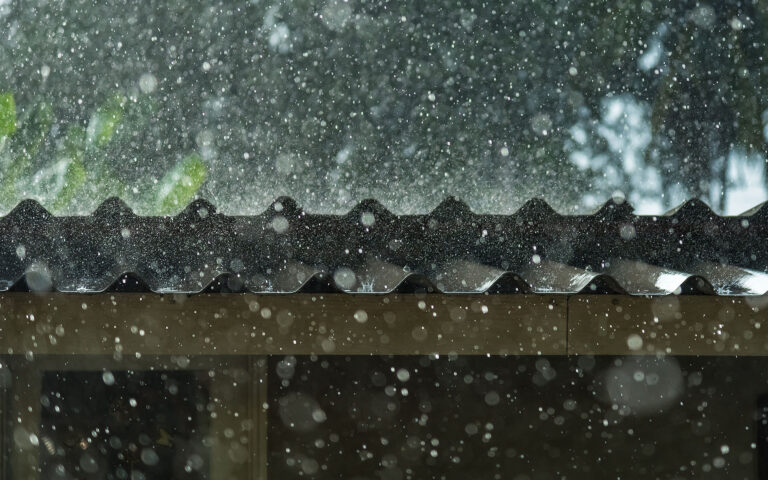Your roof serves as the shield of your home, protecting you and your family from the elements. However, over time, wear and tear can lead to issues such as missing shingles, compromising the integrity of your roof.
Ignoring missing shingles can lead to costly repairs and potential damage to your home’s interior. In this guide, we’ll go into everything you need to know about missing shingles, including:
- How to spot them
- Their causes
- Dangers
- Replacement costs
- Prevention measures
Spotting Missing Shingles:

The first step in addressing missing shingles is to identify them. Here are some signs to look out for:
- Visual Inspection: Take a walk around your property and visually inspect your roof. Look for areas where shingles appear to be damaged, dislodged, or missing altogether. Binoculars can help you spot issues without needing to climb onto your roof.
- Check Gutters and Downspouts: If you notice granules in your gutters or downspouts, it could be a sign that your shingles are deteriorating, which may lead to missing shingles over time.
- Interior Signs: Leaks or water stains on your ceiling can indicate missing or damaged shingles allowing water to seep into your home.
Common Causes of Missing Shingles
Several factors can contribute to missing shingles:
Age:
As your roof ages, shingles can become brittle and susceptible to damage from wind, rain, and snow, leading to them becoming dislodged or falling off entirely.
Weather:
Severe weather conditions such as strong winds, hailstorms, and heavy rainfall can loosen or rip shingles off your roof.
Poor Installation:
Improperly installed shingles or using low-quality materials can result in premature shingle failure and missing shingles.
The Dangers of Missing Shingles
Ignoring missing shingles can have serious consequences:
- Structural Damage: Missing shingles can expose the underlying structure of your roof to moisture, leading to rot, mold, and even structural damage.
- Water Damage: Water can seep into your home through gaps left by missing shingles, causing damage to ceilings, walls, insulation, and electrical systems.
- Decreased Energy Efficiency: Gaps in your roof can compromise your home’s insulation, leading to increased energy bills as your heating and cooling systems work harder to maintain a comfortable temperature.
Replacing Missing Shingles: 4 Key Steps

If you discover missing shingles, it’s essential to address the issue promptly. Here’s how to replace them:
1) Gather Materials:
You’ll need replacement shingles, roofing cement, a pry bar, a hammer, nails, and a ladder.
2) Remove Damaged Shingles:
Use the pry bar to carefully lift the remaining shingles surrounding the missing ones. Remove any nails or adhesive holding the damaged shingles in place.
3) Install New Shingles:
Slide the new shingle into place, ensuring it aligns with the surrounding shingles. Secure it with roofing nails and apply roofing cement to seal the edges.
4) Replace Adjacent Shingles:
Replace any adjacent shingles that were removed during the process to maintain a uniform appearance and ensure proper sealing.
When to Opt for a Full Roof Replacement
In some cases, replacing missing shingles may not be enough to address underlying issues. Here are some signs that indicate you may need a full roof replacement:
- Extensive Damage: If a large portion of your roof is damaged or missing shingles, it may be more cost-effective to replace the entire roof rather than repairing individual sections.
- Age of Roof: If your roof is nearing the end of its lifespan, replacing missing shingles may only serve as a temporary solution. Investing in a new roof can provide long-term protection and peace of mind.
- Multiple Repairs: If you find yourself frequently repairing missing shingles or experiencing recurring leaks, it may be time to consider a full roof replacement to address underlying issues.
Cost to Replace Shingles
The cost of replacing missing shingles can vary depending on several factors, including the extent of the damage, the type of shingles used, and your location. On average, homeowners can expect to pay between $100 and $300 per square (100 square feet) for asphalt shingle replacement. However, prices may be higher for premium materials or if extensive repairs are needed.
Avoiding Future Shingle Loss
Prevention is key to avoiding missing shingles in the future. Here are some tips to help protect your roof:
🔎 Regular Inspections:
Schedule annual inspections with a professional roofer to identify and address issues before they escalate.
🌳 Trim Overhanging Branches:
Tree branches hanging over your roof can cause damage during storms. Trim back any branches that pose a threat to your roof.
💰 Invest in Quality Materials:
Choose high-quality shingles and have them installed by experienced professionals to ensure durability and longevity.
🍂 Maintain Gutters and Downspouts:
Keep your gutters and downspouts clear of debris to prevent water backup and potential damage to your roof.
Your Roof Shingle Experts
Missing shingles are a common issue that can compromise the integrity of your roof and lead to costly repairs if left unaddressed. By knowing how to spot missing shingles, understanding their causes and dangers, and taking prompt action to replace them, you can protect your home and ensure the longevity of your roof. Additionally, investing in regular maintenance and following prevention measures can help minimize the risk of future shingle loss, providing you with peace of mind and preserving the value of your home.
Contact Tectum Roofing today to work with a roofing contractor who can help deal with just one missing shingle or a whole roof replacement!




